.
As a fundraiser, we asked thirteen artists we’ve worked with to produce prints for a boxed portfolio. The portfolios were for sale to members of our Foundation at a special event on 22 October 2020. They all sold—a big success. Thanks to everyone. Here are the Box Set 2020 liner notes.
This portfolio emerges from and celebrates City Gallery Wellington’s programme. On the occasion of the Gallery’s fortieth anniversary, we invited thirteen New Zealand artists who we’ve worked with in recent years to contribute a Giclee print. We included artists from different generations—established names and newer figures—whose work we knew would suit the medium.
The project’s purpose is to raise funds for City Gallery Wellington Foundation, to support the work of the Gallery. We produced fifty-five sets, forty for sale, thirteen for the artists, and two for City Gallery’s archives.
In developing this miscellany, our curators had two earlier boxed sets in mind aesthetically. One was David Bailey’s Box of Pin-Ups (1965). Containing thirty-six loose reproductions of celebrity studio portraits by the London photographer, it epitomised the swinging 1960s. The other was Multiples (1969), published by Auckland’s Barry Lett Galleries. These twelve screenprints by canonical New Zealand painters—including Don Binney, Ralph Hotere, Colin McCahon, and Gordon Walters—helped popularise New Zealand contemporary art.
Our thanks go to the Box Set 2020 artists, for generously supporting this project. If you have acquired Box Set 2020, we thank you too. Thanks to the artists and collectors both, for supporting our ongoing work—to present the best of contemporary art.
Elizabeth Caldwell, Director | Kaitohu Matua, City Gallery Wellington Te Whare Toi / Jan Kelly, Chair | Heamana, City Gallery Wellington Foundation
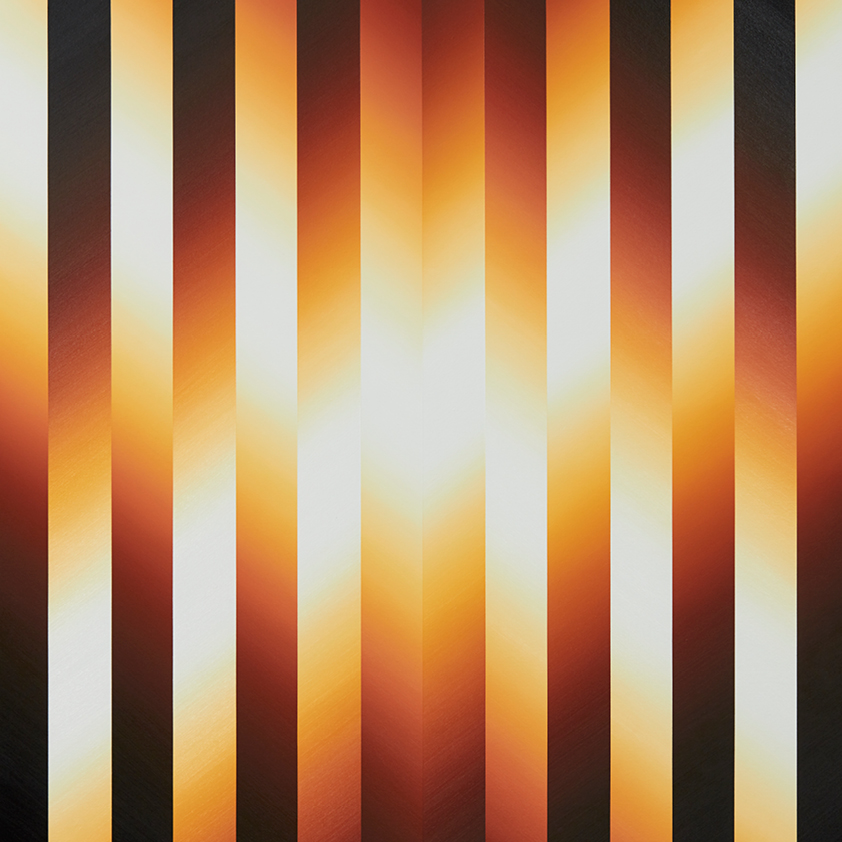
Martin Basher (b.1979) Untitled 2017/2020
Martin Basher addresses the aesthetics and politics of display, the points where art and commercial display meet and blur. In 2014, City Gallery presented his show Blackberry Schnapps, featuring work he had just made as artist in residence at McCahon House in Titirangi. Untitled digitally restages a painting from Basher’s 2017 show Hawaiian Tropic at Starkwhite, Auckland. Its hard-edged geometry speaks to modernist abstraction; its strobe-like light effects and surface gleam suggest retail-display fittings; its blinding light and hot colour palette are drawn from found photos of exotic landscapes. The original work translated these elements into painting. Untitled translates them back into digital form, closing the loop. Basher is represented by Starkwhite, Auckland; and Anat Ebgi, Los Angeles.

Andrew Beck (b.1987) Dissipative Structure 2020
Today, photography is digital and odourless. But, in the past, photographers worked their magic with light and smelly chemicals, processing film and prints in tanks and baths—‘wet photography’. Wellingtonian Andrew Beck’s pristine abstract photos look futuristic, even ‘digital’, yet are produced using old-school, analogue, wet techniques. Typically hybrids of photogram (cameraless photography) and painting (painted coloured-glass mattes), their clean geometries recall both early-modernist painting (particularly suprematism) and digital effects (like ‘flocking simulation’). Looking both to the future and the past, his works evade easy pigeonholing. Since 2015, Beck has also been making photograms of agitated water, by exposing sheets of photographic paper submerged in baths. These unique images register, in negative, the shadows cast by the liquid’s ripples and swirls— fleeting forms Beck can barely control. Originally made as ‘drawings’ to prompt ideas for new work, he has begun showing them as works in their own right. While they seem diametrically opposed to his trademark geometries, his Dissipative Structures reveal the basis and depth of his interest in light refraction and energy fields, while referring back to the chemical baths found in the darkroom of old—photography’s primal scene. Beck is represented by Visions, Auckland.
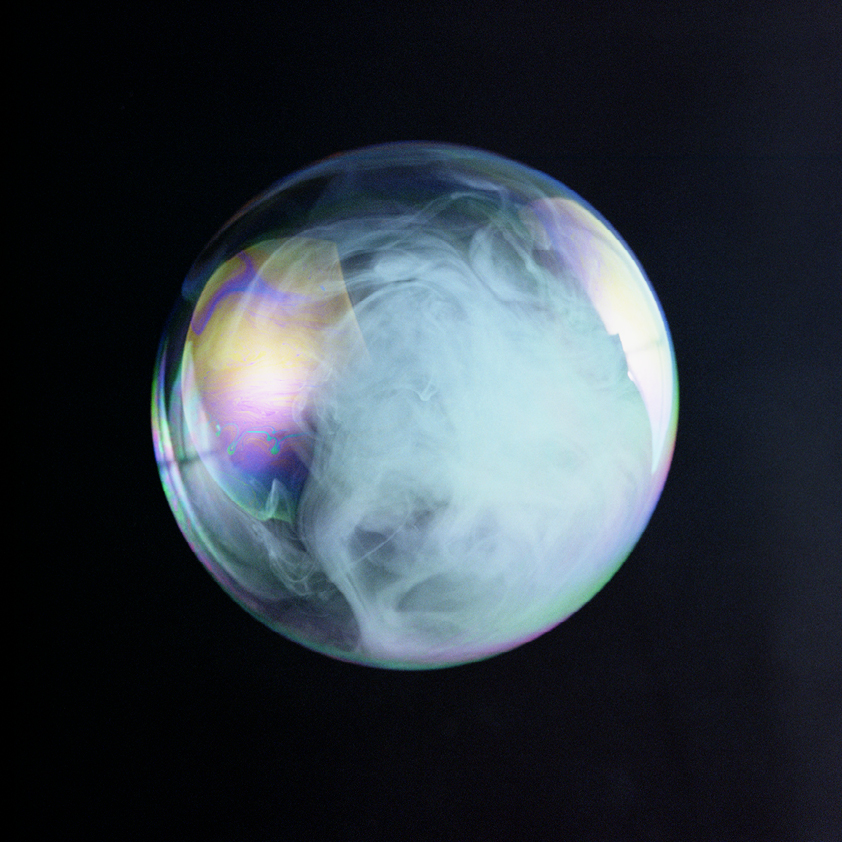
Steve Carr (b.1976) Smoke Bubble 10 2016
Soap bubbles and wisps of smoke are stock motifs in vanitas still-life painting. Their fugitive qualities remind us of the brevity of life. In his 2016 series Smoke Bubbles, Steve Carr doubles down on death by combining them, photographing soap bubbles filled with cigarette smoke. He captures these evanescent entities against darkness, depriving them of any sense of scale. Carr’s spheres seem at once cloudy and iridescent, like unique and mysterious planets shrouded by their atmospheres. Time is one of Carr’s big themes. He is famous for making video works that explore duration, making us wait for a watermelon to explode or owers to change colour. But here, he grants permanence to an ephemeral beauty. Carr’s work featured in our 2016 show Bullet Time, and we presented his video installation Chasing the Light in 2019. Carr lives in Christchurch, where he is Senior Lecturer in Film at Ilam School of Fine Arts at the University of Canterbury. He is represented by Michael Lett, Auckland; and Station, Melbourne.
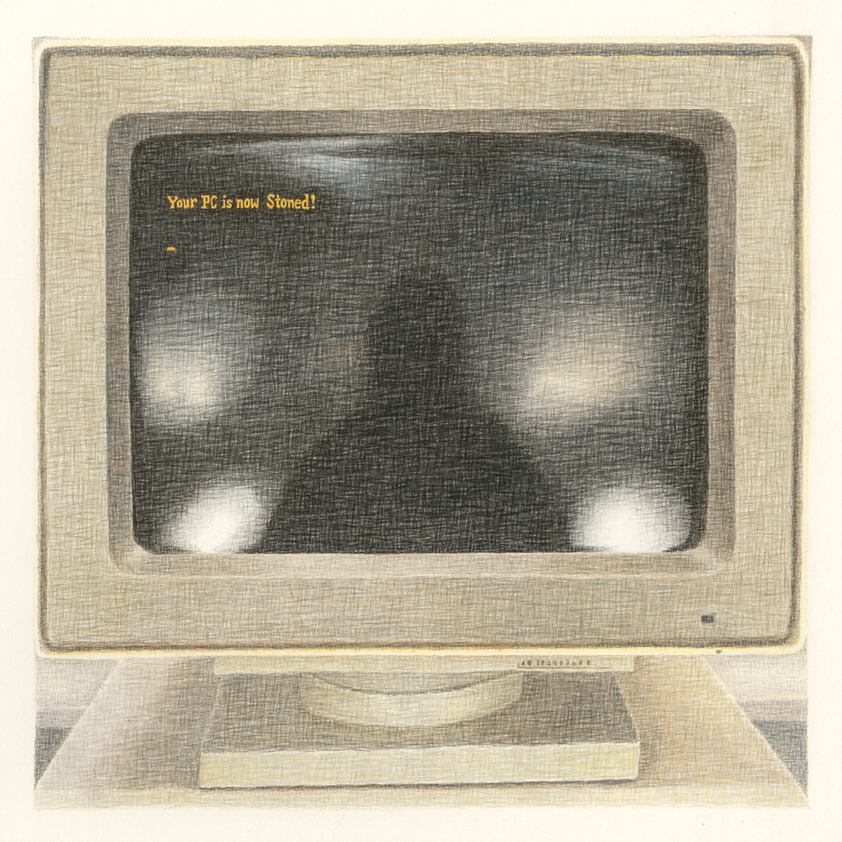
Bronwyn Holloway-Smith (b.1982, Pākehā) Stoned_01 2020
Bronwyn Holloway-Smith explores national identity, public art, new technologies, and the power dynamics shaping knowledge and information. Based in Te Whanganui-a-Tara Wellington, she pursues these interests in her work and in other forums. Her work has featured in several City Gallery shows. For The Obstinate Object: Contemporary New Zealand Sculpture in 2012, she made models of other artists’ works in the show that could be downloaded and 3D printed. Her PhD project, The Southern Cross Cable: A Tour, starred in 2018’s This Is New Zealand. Here, her drawing (the first in a forthcoming series) refers to one of the first PC viruses, the ‘Stoned’ virus. Created by a young Wellington programmer in 1987, it spread quickly throughout Australasia, with variants springing up around the globe. Infected computers displayed the message ‘Your PC is now Stoned!’, along with the phrase ‘Legalise Marijuana’. Holloway-Smith’s highlighting of this story takes on a strange new relevance in a year marked by another sort of virus and a referendum on whether to legalise cannabis.

Yona Lee (b.1986) In Transit (3D Pipes) 2020
Yona Lee’s snaking, maze-like installations of cut-and-welded stainless-steel pipes have been seen around the world, including presentations at Sydney’s Art Gallery of New South Wales (2018), Lyon Biennale (2019), and Busan Biennale (2020). In 2018, she made the fifth iteration of her In Transit project for City Gallery. It spread across two downstairs galleries and the auditorium corridor, tracing the movement of utility pipes.Her 3D computer-generated drawings initially served a preparatory function for her installations but have started to take on a life of their own. Following rather than preceding her sculptures, they now play out and rewrite the relationships her sculptures have to the body and spaces unrestricted by gravity or framing architecture. Continuing to push the possibilities of these digital drawings, she is currently investigating animating them. Lee lives in Auckland and is represented by Fine Arts, Sydney.

Judy Millar (b.1957) Ears of a Donkey 2018
There was a time when painterly gestures seemed full of passionate intensity, yet today we tend to see them as conventional—signs of ‘expression’, tropes. Judy Millar wants to keep the baby and the bath water. Her paintings feel intensely physical and highly mediated. She famously ‘paints backwards’, using her hands to wipe paint off her canvases, creating springy exaggerated ‘brushstrokes’ that seem to float in illusionistic space. Here, she presents not a painting but a photo of her hand dripping gold paint. She originally made it as a ‘supplementary promo image’. Is it a quip about ‘the hand of the artist’ or her Midas touch? Millar was last seen at City Gallery back in 2007, in Prospect: New Art>New Zealand. Two years later, she represented New Zealand at the Venice Biennale. These days Millar splits her time between Auckland and Berlin. She is represented by Gow Langsford Gallery, Auckland; Robert Heald, Wellington; Nadene Milne Gallery, Christchurch; Sullivan and Strumpf, Sydney and Singapore; and Galerie Mark Müller, Zurich.
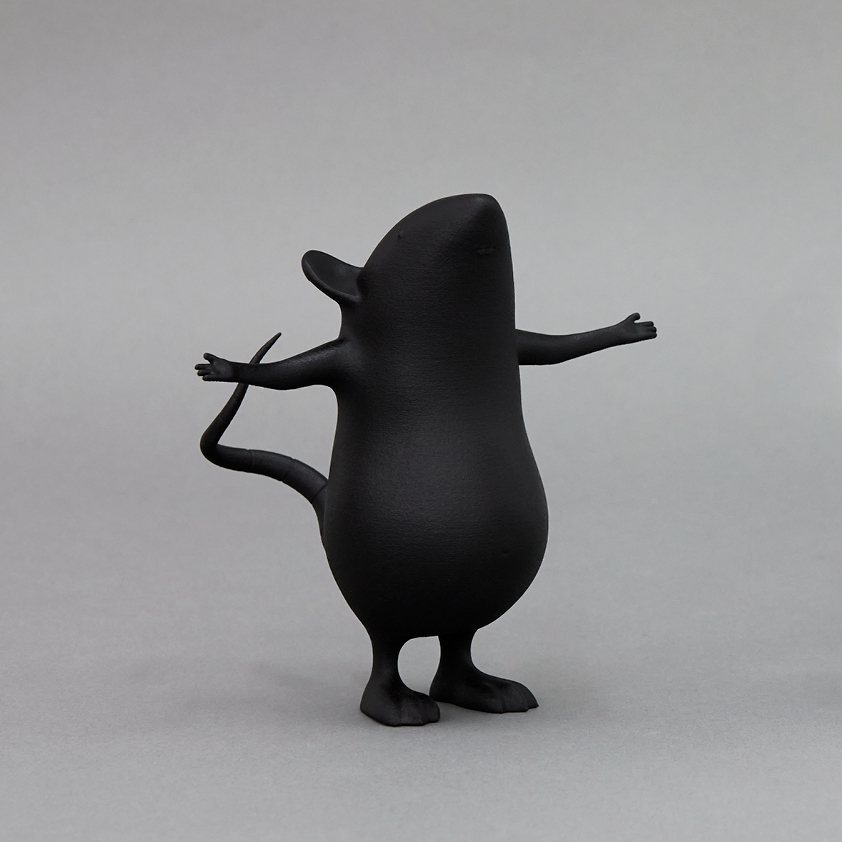
Seung Yul Oh (b.1981) Pou Sto 2020
Seung Yul Oh’s improvisational approach to forms, materials, and spaces has made his work a fixture in galleries and museums in New Zealand and South Korea. He works across painting, drawing, sculpture, installation, performance, and video, animated by a sense of chaotic energy and play that often seeks audience participation. In 2014, City Gallery Wellington collaborated with Dunedin Public Art Gallery to stage Moamoa, a Decade, his first survey show. It included wall paintings, an inflatable labyrinth, and fake-noodle sculptures. Pou Sto belongs to Oh’s menagerie of creatures real and imagined, and specifically to a family of cute, cartoony mice. Oh often plays up the relationship between his mice and the viewer, knowing that even the most adoring viewer would likely recoil in horror if a real rodent darted across the floor. Here, he presents his mouse through a kind of photographic portrait. In ancient Greek, Pou Sto refers to the search for ‘a place to stand’—which is exactly what Oh’s creatures, art works, and audiences constantly negotiate with each other. Oh lives in Auckland and is represented by Starkwhite, Auckland.
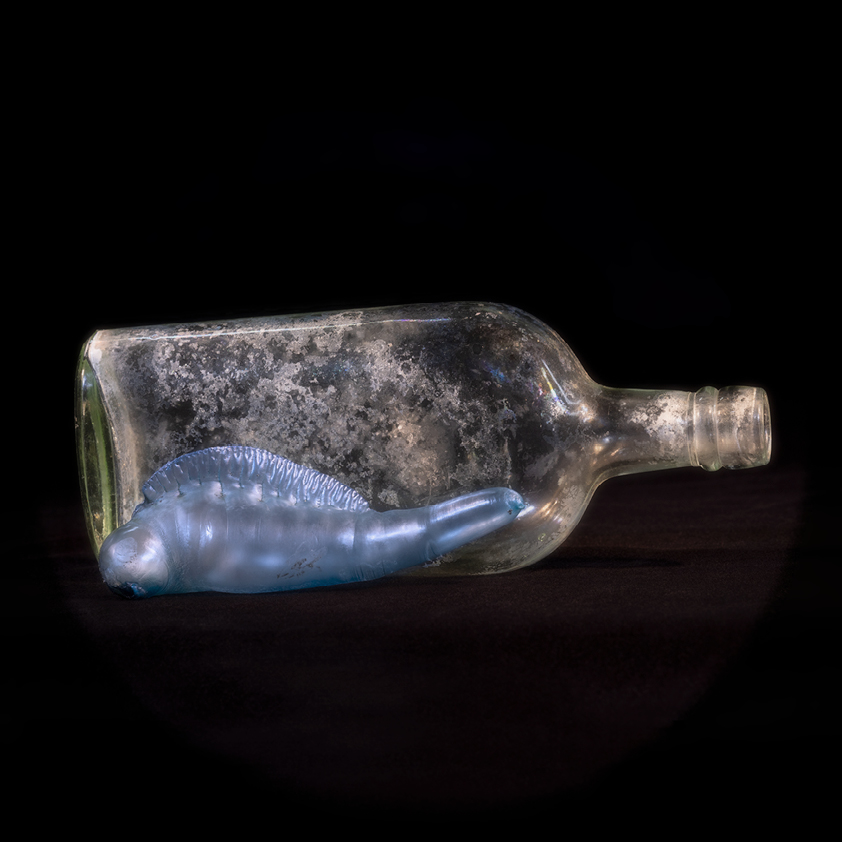
Fiona Pardington (b.1961, Ngāi Tahu, Kati Mamoe, Ngāti Kahungunu, and Clan Cameron of Erracht) Covid-19 Hand-Dug Bottle and a Piha Man O’ War: Nightwalking Level 4 2020
Fiona Pardington’s photography hinges on her mastery of her medium and her own mediumistic abilities. Her ongoing still-life project is alive to the range of forces present in images and objects she encounters in the world. Her ritualistic process is a form of sympathetic magic that starts with a daily salvaging of objects—many of which she nds washed up onto the beach and accepts as ‘gifts of Tangaroa’. This photograph emerges from one of Pardington’s night walks on Piha Beach during lockdown. Against a velvety black background, an ihumoana (stinging jellyfish) washed ashore sits in front of a glass bottle dug from the sand. Relating organic and inorganic, opacity and transparency, soft and hard, surreal and everyday, it offers a classic Pardington twist on the still life. This hypnagogic ‘message in a bottle’ is made at and for a time when the relationship between humans, the natural world, and the one we have built for ourselves has been thrown off its axis. In 2015, City Gallery staged Pardington’s survey exhibition A Beautiful Hesitation, which toured to Auckland Art Gallery and Christchurch Art Gallery. The hero image was a lush still life, featuring salvaged bottles, roses, persimmons, and a colander teaming with ihumoana. Pardington lives in Piha and is represented by Starkwhite, Auckland.

Elisabeth Pointon (b.1992) WOULD YOU LOOK AT THAT AGAIN. 2020
In 2012, the art fair Art Basel Miami Beach commissioned ‘fifteen of the most seminal figures in text art’ to create text works to be flown behind aeroplanes. The line-up included just three women, and no one of colour. Jack Pierson’s banner reeked one-percenter privilege, declaring ‘WE’RE RICH WE CAN DO WHAT WE WANT’. Questioning who gets to speak, where, and how, Wellington-based Pākehā-Indian artist Elisabeth Pointon responded by flying her own banners bearing generic tongue-in-cheek taglines, including ‘SPECTACULAR.’ and ‘OUTSTANDING.’. (Her slogans always include a full stop—a ‘bindi’.) Pointon’s print shows her banner ‘BIG DEAL.’ flying over Auckland Art Fair on 4 May 2019. Pointon’s ‘SPECTACULAR.’, ‘OUTSTANDING.’, and ‘BIG DEAL.’ banners featured in her 2019 City Gallery show What Goes Up. They are part of her ongoing project, détourning the generic language of capitalist boosterism.

Patrick Pound (b.1962) Reflectors 2020
Patrick Pound turns collecting into art, creating idiosyncratic ‘museums’— including Photography and Air, People Who Look Dead but (Probably) Aren’t, and The Museum of There, Not There. The two photos reproduced here featured in his 2018 City Gallery show On Reflection, a follow-up to his humbly titled 2017 show The Great Exhibition at the National Gallery of Victoria in Melbourne—the city he has called home for more than twenty years. On Reflection located doubles, doppelgängers, and mirrors in scores of found images and objects drawn both from Pound’s own collections and from Te Papa’s. The show was installed to mirror itself, like a giant Rorschach test. These photos—of a woman diving into water and a man poking his head out a window—were stand-ins for viewers reflecting on Pound’s algorithmic assemblage. Pound is represented by Hamish McKay, Wellington; Melanie Roger Gallery, Auckland; Station, Melbourne; and Darren Knight Gallery, Sydney.

Jono Rotman (b.1974) Notorious Son Dog Reads King Notorious Roy RIP, Waipawa, MMXVIII 2018
There are few topics more polarising than gangs. Famously violent, New Zealand’s Mongrel Mob has always operated on the fringes of mainstream society. Most of its members are Māori, and many have been victims of state and family abuse. Gang life provides them with community and whanau. Part of New Zealand’s colonial legacy, the Mob has its own lore and iconography. Perversely, its totems include both the British bulldog and the Nazi swastika. Over many years, photographer Jono Rotman has documented Mob members and their own photos and talismans, culminating in his 2015 show Mongrel Mob Portraits at City Gallery and his 2018 book Mongrelism, with its suggestively redacted text. In this image, Notorious Son Dog, worldwide captain of Mongrel Mob Notorious, reads from the thirteenth bark of King Notorious Roy (RIP 2014) from Mongrelism. Son Dog wears the rings of other Mob hapu and one to represent MMMighty Henry battle wagons (Ford V8s). Originally from the Wellington region, Rotman now lives in San Francisco. He is represented by Gow Langsford Gallery, Auckland.

Yvonne Todd (b.1973) Alice Bayke (Outtake) 2002/2020
Auckland photographer Yvonne Todd is known for her studio portraits of imaginary female characters with invented names—wigged, costumed, made up. Often tainted with tragedy, her portraits prompt us to imagine her sitters’ back stories. The glamorous woman in Alice Bayke (Outtake) looks like she’s stepped out of Valley of the Dolls. The shot came from the sessions for Todd’s series Sea of Tranquility, made in 2002—the year she won the Walters Prize. Todd said she styled her models for this series like ‘the daughters of Mormon pastors, circa 1969’—the year of the moon landing. Bayke’s frosted wedding gown reminded one critic of the lunar surface—remote and airless. Sea of Tranquility featured in Todd’s City Gallery retrospective Creamy Psychology in 2014. She is represented by McLeavey Gallery, Wellington; Ivan Anthony, Auckland; and Fine Arts, Sydney.
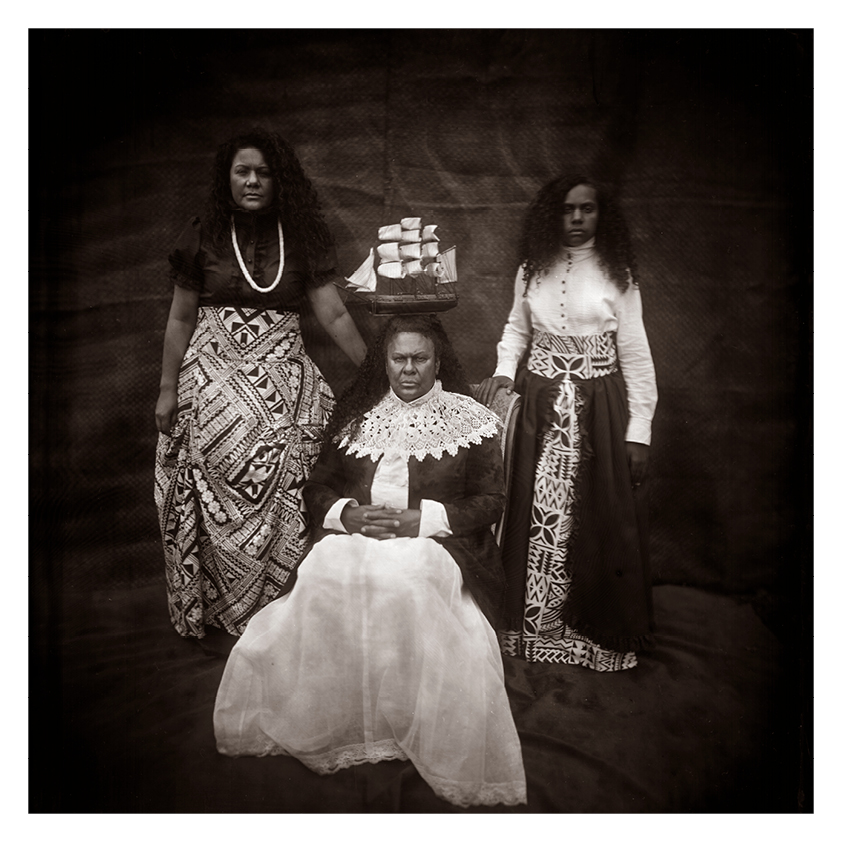
Jasmine Togo-Brisby (b.1982) Adrift Amidst the Middle Passage II 2019
Jasmine Togo-Brisby addresses the shameful history of the Pacific slave
trade (known as ‘blackbirding’). The Wellington artist is a fourth-generation Australian South Sea Islander. As children, her great-great-grandparents were taken from Vanuatu and forced into domestic servitude in Sydney. She says: ‘I’m interested in examining the effects of trauma transmitted through ongoing oppression across generations, particularly in contrast to the inheritance of wealth that has come to those who benefit from slavery and colonisation.’ Here, her family photo shows three generations of women: the artist, her mother, and her daughter. Her mother wears a model sailing ship as a headdress, recalling the ships that carried her ancestors to Australia. Made using the antique collodion photographic process, the image has a nineteenth-century look. In 2017, City Gallery presented the show Colonial Sugar, placing Togo-Brisby’s work in conversation with Tracey Moffatt’s photo series Plantation. Togo-Brisby is represented by Page Galleries, Wellington.
Co-ordinator Nicki Manthel
Curators Robert Leonard and Aaron Lister
